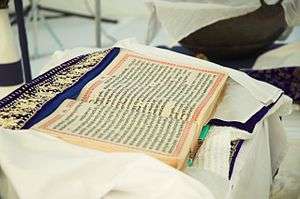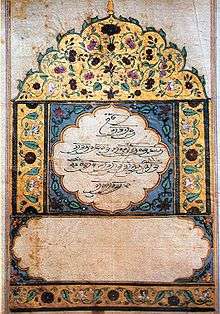Guru Maneyo Granth

Guru Maneyo Granth (English: Granth Be Thy Guru), refers to the historic statement of the 10th Sikh Guru, Guru Gobind Singh (1666–1708), shortly before his death, on affirming the sacred text Adi Granth as his successor, thus terminating the line of human Gurus. Installed as the Guru Granth Sahib, it is now the central text of Sikhism, and the eternal Guru of all Sikhs. It is central to Sikh worship as it is said to imbibe a living spirit of Ten Sikh Gurus.[1]
The event on 20 October 1708 at Nanded (in present-day Maharashtra), when Guru Gobind Singh installed Adi Granth as the Guru of Sikhism, was recorded in a Bhatt Vahi (a bard's scroll) by an eyewitness, Narbud Singh,[2][3][4] and is now celebrated as Guru Gaddi (Guru Gaddi Divas), and statement is part of the central chant, Sabh Sikhan ko Hukam Hai, Guru Maneyo Granth.[5] October 2008 marked the Tercentenary year of Guruship of Guru Granth Sahib and was marked by major celebrations by Sikhs worldwide,[6] and especially at Takht Sri Hazur Sahib, Nanded saw year-long celebrations.[7]
Adi Granth to Guru Granth Sahib

Punjabi: "ਸੱਬ ਸਿੱਖਣ ਕੋ ਹੁਕਮ ਹੈ ਗੁਰੂ ਮਾਨਯੋ ਗ੍ਰੰਥ"
Transliteration: "Sab sikhan kō hukam hai gurū mānyō granth"
English: "All Sikhs are commanded to take the Granth as Guru."
- Guru Gobind Singh, October, 1708, Nanded
The composition of the sacred Granth contains renderings of the Hymns (Bani) of six Gurus of the Sikh faith and some Bhaktas and saints. It was composed in this form in the year 1604 with the later addition of Guru Tegh Bahadur's Bani (sacred compositions). Its blessings are sought by the true seeker with a devout heart. The Sikh religion sincerely believes that in each of the succeeding Gurus the spirit of Guru Nanak was operating and incarnated.
The sacred Granth is installed in all Sikh holy places of worship and treated as the presiding presence of the Guru, an apostle of Divine Truth. The devotees of the Sangat or congregation gather in solemn assembly to pray and seek the blessings of the Supreme. This comes through in the mystical wisdom contained within the words of Gurbani and it stands for realization of the Truth. The Gurus' word, known as 'sabad' is taken as the mystic experience of the Guru.
In the words of Bhai Gurdas, a great scholar of the Guru's time, "In the word is the Guru, and the Guru is in the word (sabad). In other words, the human body was not the Guru, but the light of the word (sabad) within the heart was their real personality." When the human mind dives deeper and deeper into the Guru's word, all mental impurities depart and the wisdom of the Guru permeates the human soul. Thereby the devotee attains the divine light and wisdom which leads him to contemplate and meditate on God's name (naam). In the light of the above realities, the Sikh religion makes the holy Granth the living master of the Sikh Panth.
Before he died, Guru Gobind Singh, the tenth Guru, conferred the Guruship to the [Adi Granth]. He then delivered a self-composed hymn:
- Agya bhai Akal ki tabhi chalayo Panth. Sabh Sikhan ko hukam hai Guru manyo Granth. Guru Granth Ji manyo pargat Guran ki deh.
Jo Prabhu ko milbo chahe khoj shabad mein le. Raj karega Khalsa aqi rahei na koe ,Khwar hoe sabh milange bache sharan jo hoe."
- Translation:
"Under orders of the Immortal Being, the Panth was created. All Sikhs are enjoined to accept the Granth as their Guru.
Consider the Guru Granth as an embodiment of the Gurus.Those who want to meet God, can find Him in its hymns. The pure Khalsa shall rule, and the impures will be left no more, Those separated will unite and all the devotees of the Guru shall be saved."
He also offered his obeisance to the sacred Granth thus conveying his Light to it. This historic development took place in Oct. 1708 which ensured that the order of the Khalsa brotherhood always remained an abiding force for Sikh Panth unity.
Mool Mantar
The Guru Granth Sahib begins with the Mūl Mantar, an iconic verse created by Nanak:
- Punjabi: ੴਸਤਿਨਾਮੁਕਰਤਾਪੁਰਖੁਨਿਰਭਉਨਿਰਵੈਰੁਅਕਾਲਮੂਰਤਿਅਜੂਨੀਸੈਭੰਗੁਰਪ੍ਰਸਾਦਿ॥॥ਜਪੁ॥ਆਦਿਸਚੁਜੁਗਾਦਿਸਚੁ॥ਹੈਭੀਸਚੁਨਾਨਕਹੋਸੀਭੀਸਚੁ॥੧॥
- ISO 15919 transliteration: Ika ōaṅkāra sati nāmu karatā purakhu nirabha'u niravairu akāla mūrati ajūnī saibhaṅ gura prasādi. japu. ādi sachu jugādi sachu. hai bhī sachu nānaka hosī bhī sachu
- Simplified transliteration: Ik ōaṅkār sat nām kartā purkh nirbha'u nirvair akāl mūrat ajūnī saibhaṅ gur prasād. jap. ād sach jugād sach. hai bhī sach nānak hosī bhī sach
- English: One Universal Creator God, The Name Is Truth, Creative Being Personified, No Fear, No Hatred, Image Of The Timeless One, Beyond Birth, Self Existent, By Guru's Grace. Chant And Meditate: True In The Primal Beginning. True Throughout The Ages. True Here And Now. O Nanak, Forever And Ever True. ||1||
Historical events have clearly brought out that when Guru Nanak appeared before the Supreme Lord, he himself presented to him a cup of God's name, known as Amrita to propagate in his subjects. Guru Nanak thereafter composed Mool Mantar which defines the fundamental directive spiritual philosophy of Sikhism. It appears in the very beginning of Sri Granth Sahib, ahead of Japji.
It is composed of two elements - the figure ek (1) and logo or symbol 'onkar'. The term 'ekonkar' in full form was meant to describe transcendent formless god as creator, sustainer and dissoluter. The symbol 'onkar' gives mystical interpretation of immanent spirit of god and his becoming aspect which created the universe. It is a well known fact that this universe was created through a primodial sound (kavao), known as first wisdom of god. It acts as an intermediary between the creator and his creation. God is spirit and pure light (Jyoti) which excites every human mind to realize the truth. In Sikh mysticism, while meditating on Mul Mantar and its repetition believed to lead the soul to absorption in the absolute (Samadhi). Even its condensed forms i.e. sattinam, ek onkar, satti gurprasad or its synonymous mantras, such as waheguru or sat kartar, repeated constantly produce the same results and induce the spiritual state. While meditating on ek - or one or the sole absolute reality, the mind progresses to the realization of Onkar, the creator.
Thus God's name is not a syllable word but a code to unfold the mystic properties of divine spirit which controls the cosmic and human being through invisible law of nature. Real name of god implies expression of his pervasive personality and concrete truth of His existence. Naam demands moulding of our personality which is meant opening of our inner self to establish personal touch with reality. Therefore, one has to be ethically strong, thoughtful and rightly meditative to attain this higher truth which is immediate and principle of man. Birth as a human being is to be taken as an opportunity to achieve liberation. It is because the achievement of emancipation is possible to man alone and that too on this earth. The history of a particular individual, the number of times he experiences rebirth depends entirely upon the quality of his will, upon the moral effort he puts forth. To sum up, Sri Guru Granth Sahib of Sikh faith is a unique spiritual measure which gives an analytical view of the divine claws which are hidden from human gaze. Each chosen word of the text encodes the secret power of the eternity and blue prints of his working in the fleeting world of forms.
References
- ↑ "The making of the eternal Guru". The Hindu. Oct 26, 2008.
- ↑ Singh, Gurbachan; Sondeep Shankar (1998). The Sikhs : Faith, Philosophy and Folks. Roli & Janssen. p. 55. ISBN 81-7436-037-9.
- ↑ Kainth, Gursharan Singh (1999). "3. Historical Background of Sri Guru Granth Sahib". The Granth be Thy Guru: Guru Maneyo Granth. Daya Books. p. 28. ISBN 81-86030-97-2.
- ↑ Partridge, Christopher Hugh (2005). Introduction to World Religions. p. 223.
- ↑ "Chants of Guru Maneyo Granth rend the air". The Indian Express. Sep 2, 2004.
- ↑ Jagmohan Singh (March 19, 2008). "Guru Maneyo Granth". World Sikh News.
- ↑ "Non-Sikh family donates van for Gurgaddi Divas fest". The Tribune. November 14, 2007.
Further reading
- Guru Manyo Granth, by Harnam Dass Sahrai. Lokgeet Prakashan, 1989.